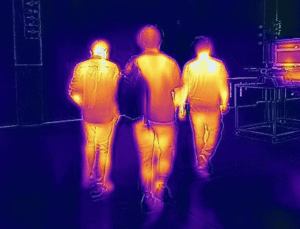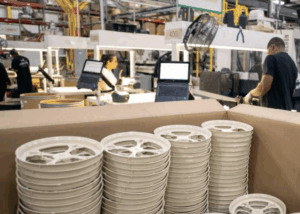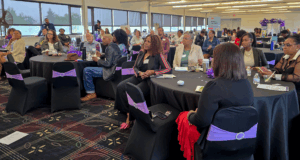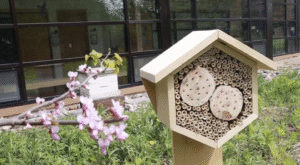
Panelists at SBND Event Discuss How Trees Benefit Individuals, Neighborhoods, and the Economy
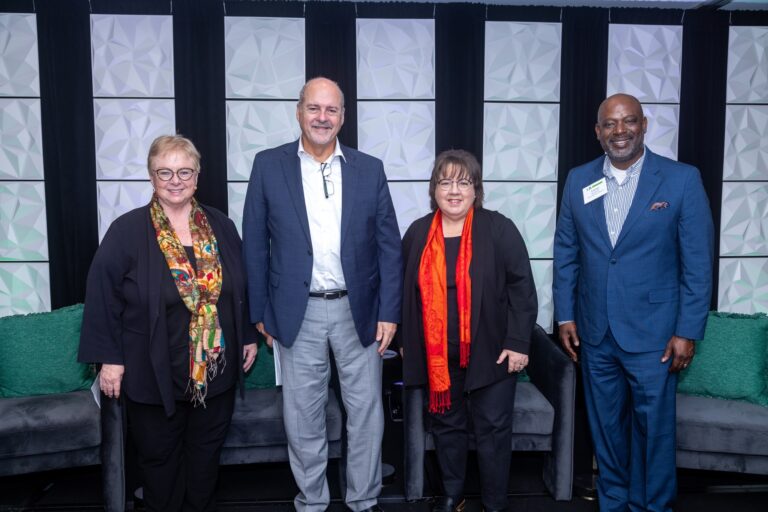
Detroit was once known as the “city of trees,” but disease, invasive insects, and budget cuts over time have decimated our area’s distinctive tree canopy. But efforts are underway to replenish trees while also providing job training, green spaces, education, and community engagement.
On Oct. 31, 2024, Sustainable Business Network Detroit hosted an informative discussion sponsored by the Fred and Barbara Erb Family Foundation regarding these efforts and how restoring tree canopy benefits individuals, neighborhoods, businesses, and the economy.
The panelists were:
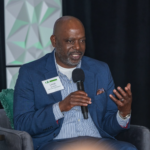
Lionel Bradford, president and executive director, Greening of Detroit, a nonprofit focused on enhancing the quality of life for Detroiters by planting trees, providing job training, and involving youth in the education of the natural environment.
It involves Detroiters in the process through community engagement, green spaces, education, and jobs.
 Maureen Donohue Krauss, president and CEO, Detroit Regional Partnership.
Maureen Donohue Krauss, president and CEO, Detroit Regional Partnership.
DRP works to serve as a single point of contact for information, connection to services, incentives, and data for businesses who want to locate or expand in the 11-county Southeast Michigan Region.
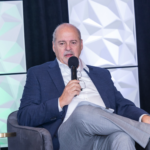
Robert Riney, president and CEO, Henry Ford Health, and leader of HFH’s $4 billion Destination: Grand initiative.
The project includes a $2.2 billion expansion of HFH’s Detroit campus anchored by a new state-of-the-art hospital facility that will span 1.2 million square feet. It includes a 20-story patient tower, with three floors dedicated to providing intensive inpatient physical medicine and rehabilitation in partnership with the Shirley Ryan AbilityLab and its own Central Energy Hub, making it one of the largest fully electric-capable hospitals in the country.
The event was moderated by Terry Barclay, president and CEO of Inforum, and chair of SBN Detroit.
Some of the takeaways:
The case for tree canopy
Lionel: Growing up in Southeast Louisiana – which is very hot – you quickly learn the value of a tree. It’s also a sportsman’s paradise – We did a lot of hunting, fishing, and camping, and I developed a great appreciation for the environment and its value. I also love people. The work that we do is about people at the end of the day, so when we do this work it’s to build community and neighborhoods. We try our very best – changing landscapes and lives is our motto.
When someone has been incarcerated for 20 years and needs a second chance, they can come through your program – the Detroit Conservation Corps – and they can be trained and support their families. You can train people to put trees in the ground and maintain them.
Maureen: Part of my role is to inform people that economic development is more than just a new factory in your town, more than just a tax abatement. It’s creating an environment that both people and companies want to be in. Sixty percent of our projects are from international companies – when people come here for the first time, they have expectations of what a first-class city looks like… Think about Paris and its phenomenal tree canopies. People want that here.
I did a little research before this event: Homes with trees sell two days faster and for 15% more than homes without. Tree value increases with age – the cost of trees has 100% payback. Three properly placed trees can reduce air conditioning by 56% and reduce home heating bills by 10% by serving as a windbreak.
Bob: You may think what does a healthcare system have to do with tree canopies? HFH is absolutely committed to increasing the health of communities – the role that hospitals and doctors play is about 20%. We don’t underestimate the power of that 20%, but true health – meaning how long people will live and have a high-value life – is a partnership of healthcare, policy, and environmental factors – which are huge. You may have seen that the biggest determinant of your health is the ZIP Code that you live in. You need to have fabulous healthcare, access to it, economic security, environmental security, and food and nutrition security.
At HFH we need to be a population health company – we pick and choose how we should make our mark and one of the things we believe in is the power of the tree. We have to walk the talk.
The economic benefits of tree canopy
Maureen: Our organization has three pillars: market, grow, and support. It’s so much better now. People are curious to hear about Detroit and see what’s happening. Talent is No. 1 – we have the second-highest amount of engineers in the country and have experienced manufacturing talent.
As one of my teammates says, it’s workforce, weather, and water. When you talk about climate change, Michigan will be in the top five least affected.
The right amount of tree canopy and how trees are sourced
Lionel: American Forests did a study and determined that a city the size of Detroit should be at 40%. Right now we’re at 26%. We lose about 2,000 trees a year, so those have to be taken into account.
We get most of our trees from New York and Indiana and, more recently, Wholesale Tree Inc. in Northern Michigan. More importantly, we’re growing our own trees now – running the Walter Meyers Nursery in Rouge Park, which is owned by the city. We’re very intentional about turning into a full-fledged operational business. Last year, we harvested our first set of trees.
We have lost a lot of trees over time, and the reason we have lost a lot of those is because the city lacked the resources, and dead trees were not removed and were taken down by storms. This administration has done a great job by taking trees down when dead and dying.
Working with DTE has been quite thrilling – they have given financial support to planting trees but also to making sure that the next generation of environmental stewards are trained by supporting our Green Corps summer programs and also the tree care academy for adults to get credentials to trim trees, etc. That’s all important.
We do foresee a shortage of trees. As part of the IRA, Congress approved the largest allocation ever to urban and community forestry – $1 billion. More than 850 entities applied; there were 320 grants; 11 made it to Michigan, and Greening was one of the recipients: $9.7 million over the next five years to put trees in the ground, workforce development around the workforce, green space, and education.
How Greening of Detroit decides what types of trees to plant and where
Lionel: You need a healthy mix – the right tree in the right place. They can’t grow too high because of power lines. Roots need to grow down instead of out because of sidewalks. Some people resist having new trees planted because of previous sidewalk damage. We only plant on public land, such as right-of-way, schools, and parks.
We’re looking at neighborhoods with less than 5% tree canopy and where there is area to plant. We also look at areas of the city that are flood-prone – trees can mitigate that. We listen to the residents. We have a community planting application, and that’s where we start first.
In terms of trees that are more tolerant of where we’re planting, we like to plant native trees if we can. There is a list we work with and we consult with the city of Detroit and forestry services to identify trees less susceptible to climate change. There are about 30% Maple Trees in the city already, so we plant fewer of those.
The scope of the Henry Ford Health Destination: Grand project and how it is incorporating trees.
Bob: What we are building is collectively now a nearly $4 billion development – not all ours – within the city of Detroit – that includes a new bed tower with all private rooms – It has seemed unethical to me as private rooms proliferate in the suburbs that somehow Detroiters don’t deserve them. It’s also research-based that private rooms help improve health and lower the risk of infection and length of stays. Second, we’ll have an emergency room with 100 private bays and sound protection. It will be as tall as the Fisher Building.
We’re creating bikeable, walkable, treed space. I’m sick of seeing parks that are not designed to be used in the winter, so we’ll have evergreens, fire pits, lighting, and heated sidewalks so people can walk outdoors.
But we can do a lot with tree canopies that go beyond that – changing the look and face of the entrance to neighborhoods. If you go back in time, every neighborhood was surrounded by businesses. We need to reinstate thriving businesses by neighborhood, but we have too many commercial strips that don’t provide that entrance. Let’s figure out which commercial alternatives we need to rebuild but come up with something environmental and aesthetic for the rest of us.
What’s equally important is that we wanted to build a whole ecosystem – The Detroit Pistons are building 882 multi-income housing units around the campus. Through the Gilbert Family Foundation were able to bring the Shirley Ryan AbilityLab – the No. 1 rated rehabilitation for head trauma and other things. An MSU partnership is building a research center built on the health of communities.
Number of trees planted and what’s next
Lionel: We’re celebrating 35 years and during that time have planted about 175,000 trees with about 40,000 volunteers. We have a goal of planting 75,000 trees between 2022 and 2027 and reached the 25,000 mark this month (October). This is part of an initiative funded by DTE Energy, the city of Detroit, American Forest, and Greening of Detroit.
How Greening is funded
Lionel: We’re nowhere near where we need to be. We’re a nonprofit, so we’re funded through grants and individual giving.
One of the things we’ve done is start a social enterprise so we can bid on contracts to do the kind of work that we do. That kind of fee for service is important – we don’t often receive money for operations, but it takes trucks and all kinds of things we don’t get through a grant.
We were awarded $10 million over five years from the Inflation Reduction Act, the largest for this kind of work. But because they’re federal, they’re reimbursable grants – you have to do the work first, and you can’t buy anything over $4,999. The operations component is 10%. So you can’t buy trucks.
Engaging the business community
Lionel: There isn’t a corporation in town that hasn’t volunteered, and that provides an opportunity to talk about the importance of tree canopy.
Optimism about the future
Lionel: I’m very excited about the city and that we have the opportunity to plant 150,000 trees. We’re very focused on trees and workforce development. We don’t want to impose our will. We want to be invited into communities and help communities be part of the work – get everyone involved.
And, workforce development is very important – training folks with barriers to employment, training people coming out of incarceration – about 64% of those we work with are returning citizens.
Maureen: – Five years ago this would have been a different conversation. I believe that our region has finally figured out that by collaborating we win more. I’ve done this work since I was a college intern – instead of everyone looking at how Minneapolis or Atlanta does it, they’re coming here. We had 125 people from Tulsa, Oklahoma, who wanted to know our secret sauce. I was asked to testify before a U.S. House Committee about how Detroit does this so well.
Bob: I’m a culture wonk who has studied the power of cultures, and I have a deep-rooted belief in the power of momentum – positive or negative. What we’re seeing in the region is such an effective positive momentum – the belief that we can do things and don’t have to copy others – and that it takes partnership to do it.
If you missed the event, don’t worry. You can view it here.
Be sure to subscribe to our newsletter for regular updates on sustainable business practices in and around Detroit.
Guest
- All
- Business
- Community
- Education
- Events
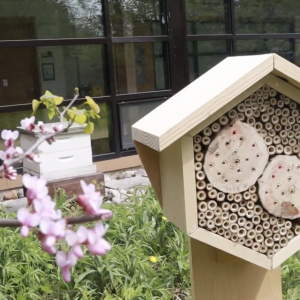
Pollinators are essential to Michigan’s ecosystems, food systems, and long-term environmental resilience — yet they face increasing threats from habitat loss, pesticides, disease, and climate change. As Southeast Michigan looks for scalable, science-based approaches to ecological stewardship, the University of Michigan-Dearborn has emerged as a voice in pollinator conservation, sustainability, and community education. SBN Detroit interviewed Dr. David Susko, Associate Professor of Biology and Chair of Biology in...
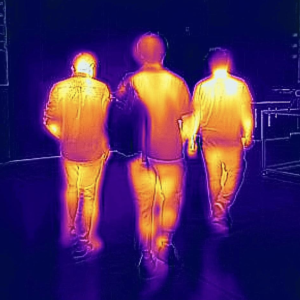
ThermoVerse is a Detroit-based urban innovation startup founded by engineer and researcher Shantonio Birch. The company’s work centers on advanced thermal energy storage and people-focused building technologies that reduce waste, stabilize indoor environments, and free up electrical capacity. SBN Detroit interviewed Birch about the future of grid resiliency, energy equity, and why Southeast Michigan is positioned to lead in next-generation smart city innovation. Q: What is the impetus...
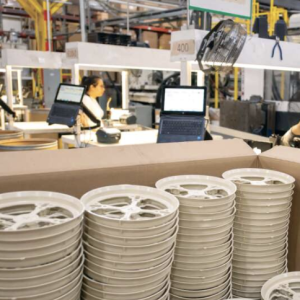
In the manufacturing world, sustainability is increasingly defined not just by recycling, but by what kind of recycling. For PolyFlex Products, based in Farmington Hills and part of Nefab Group, the future lies in creating closed-loop systems where materials are reused for equal or higher-value purposes — not simply “downcycled” into lower-grade goods. PolyFlex, which designs and manufactures reusable packaging and material handling solutions for the automotive and...


